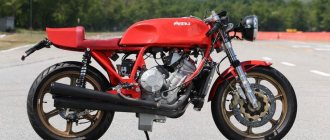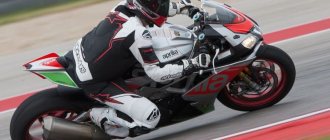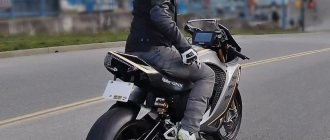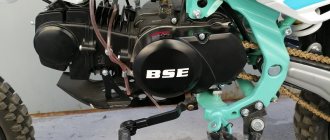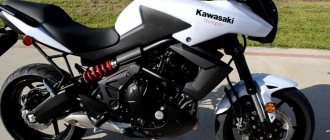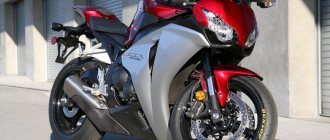Ilya [mrjoe]
21.10.2017,
Over the past 15-20 years, cinema has shown many films about cars, motorcycles and other equipment, including autobiographical ones, such as “Race”, “The Fastest Indian” and blockbusters with a fictional but very exciting plot: “Fast and the Furious”, “Taxi”, "Carrier" and so on. They are all good and interesting in their own way. Some are about professionals in their field, friendship and brotherhood, some are about improving oneself and technology, and some are just sparkling comedies that create a positive mood. The film “The Fastest Indian,” starring Anthony Hopkins, brought together all the best that cinema has to offer (with the exception of fantastic special effects and computer graphics). However, we will not be talking about a feature biographical film that was released on the wide screen in 2005, but about a man who dedicated his life to fulfilling his cherished dream - to set a world speed record on a motorcycle.
Burt Munro is the hero of today's review. In 1967, he set a speed record on dry lake Bonneville, which is located in the USA. The lake has a perfectly flat surface entirely consisting of salt deposits. The motorcycle's officially recorded speed was 295 km/h, but during the preliminary run Monroe reached 331 km/h. For motorcycles with a volume of up to 1000 cm/cc, the record has not yet been broken. The history is remarkable in that the motorcycle was produced in 1920 and was modernized for almost half a century.
Youth
Bert Monroe's youth took place at the beginning of the twentieth century. These were the golden years of technological progress. Motorcycles, cars, planes, trains - all this fascinated the young man. And Bert really wanted to see the big world with his own eyes. Soon Monroe Jr. joined the army and returned home only after the end of the 1st World War. His father sold the farm and had nowhere to work, so the future racer got a job as a construction worker. Soon the head of the family decided to take up farming again, bought a plot of land and called his son back.
Early life
Herbert James Monroe born 25 March 1899 in Invercargill, New Zealand, the son of William Monroe and Lily Agnes Robinson. He grew up in Edendale, east of Invercargill. At the time of his birth, doctors doubted Monroe's survival. He had a stillborn twin sister.
Monroe was 15 years old when he started riding motorcycles. He also loved to ride around the farm on the fastest horse in his family, much to his father's resentment. Monroe was eager to explore a world of adventure beyond his farm, something his family did not approve of. Bored with his mundane life on the farm, Monroe took an interest in the war after World War I. He believed that this would also allow him to see the world.
Monroe continued to work on the family farm until World War I ended and his father sold the farm. He then worked on the construction of the Otira Tunnel until he joined his father on their newly purchased farm.
By then Monroe was a professional speedway racer. He returned to the family farm when the Great Depression began. He simultaneously worked as a motorcycle salesman and mechanic, as well as racing motorcycles, which brought him fame in New Zealand motorcycle racing.
Monroe drove a Douglas until he could afford a British-built Clyno with sidecar, which he later sold to a blacksmith. He bought an Indian Scout, which he modified and drove throughout his life. Monroe later purchased a 1936 Velocette MSS, which he also modified and used for racing.
"Velochette MSS"
By that time, Bert Monroe, about whom a film would be made in 2005, had acquired another motorcycle, the Velocette MCC. He also modified it: installed slick tires, modified the suspension, made new parts for the engine and re-welded the frame. Thus, the rider reduced the weight of the bike and increased the engine capacity to 650 cc. Bert mainly used the Velocette for straight racing.
Made Invercargill famous
Bert Monroe brought worldwide fame to his hometown - the southernmost and westernmost town in New Zealand. And he did not remain in debt. Today here, at the Bert Monroe Museum, you can see that very fast Indian and get acquainted with the exhibition dedicated to the legendary racer and inventor. The museum has become especially popular since 2005, when the film starring Anthony Hopkins was released. By the way, the actor starred in the film for a ridiculous fee. This is the second film about the legendary racer, and the first, “Offerings to the God of Speed,” was released in 1971.
Burt Monroe's speed record
Ten years later, the racer's bikes were so fast that none of New Zealand's bikes could match them. Bert decided to go to the dry lakes in Australia, but changed his mind after visiting Bonneville in 1957. Monroe wanted to set records on a salt lake that was located in Utah. In 1962, he took all his savings, borrowed money from friends and left for America on a cargo ship. But even the available funds were not enough for him. Monroe had to work part-time as a cook on this ship. Upon arriving in Los Angeles, he bought an old station wagon for $90, attached a trailer with an Indiana to it, and drove to Bonneville Salt Lake in Utah.
It should be noted that the rules for participating in the race were strikingly different from those in New Zealand. At home everything was simple - I came, registered and went. Here Bert was not allowed to enter the race, since he did not inform in advance about his participation. Monroe was helped by famous racers and American friends who were able to come to an agreement with the organizers.
In total, the hero of this article has been to Utah ten times. He became as popular in the media as Bert Stern, Marilyn Monroe and other celebrities of the time. The first time he came there was in 1957 to set a speed record. And the other nine times I simply took part in races.
In August 1962, the fastest at Bonneville was Bert Monroe. The speed record was almost 179 miles per hour, and the driver set it in his first race. The engine capacity of his motorcycle was 850 cubic meters. Monroe later set two more records - 168 mph (1966) and 183 mph (1967). At that time, his scout's engine was increased to 950 cc. In one of the qualifying races, Monroe managed to reach a record speed of 200 miles per hour. But, unfortunately, this race was not officially taken into account.
Bert Monroe - the fastest Indian
On March 25, 2012, the famous designer, motorcycle racer, author of several very popular quotes and simply a symbolic person for all motorcycle enthusiasts would have turned 113 years old. We will tell you about his path and achievements.“If you don’t follow your dreams, then you’re probably not a person, but a vegetable... Cabbage, for example” - the phrase uttered by Bert became a household word, it was the one uttered by Anthony Hopkins as Bert himself in the famous film “The Fastest Indian” (2005), which, as stated in the credits, is based on an absolutely true story. Hopkins was so moved by the New Zealander's story that he decided to play him without regard to the size of the fee, which seems very modest by real standards. The film's writer and director, Roger Donaldson, carefully and lovingly brought Bert's entire life story to the big screen - without embellishment or exaggeration. Some of the events on the screen seem so unreal and incredible that you can only believe in their veracity by studying the letters of the main character himself.
Bert Monroe was born in 1899 in New Zealand. In 1920, he purchased an Indian Scout, and for 44 years he dreamed of making it the fastest motorcycle in the world. In our time - the time of high-tech technology, corporations and research centers, he fought for his dream with only a bright head, a pair of hands and an old motorcycle. His efforts were rewarded - his dream came true in 1967. On Lake Bonneville, Berthome set a world speed record for a motorcycle. At that time, his “Scout” was 47 years old, and he himself was 68.
The hero of the story purchased his very first motorcycle in 1915 at the age of 16. After some time, Bert had saved a whopping £50 and bought a new Clyno, complete with a sidecar. Having removed the stroller, he began to take part in local racing rides. Bert set his first record on the Fortos track, near his native Invercargill (New Zealand). Indian, which later became legendary, was purchased in 1920. Let us remind you that Indian is the oldest manufacturer of motorcycles in the United States; it was founded 2 years earlier by Harley Davidson. The very first “Scouts” were equipped with V-shaped two-cylinder engines with a displacement of 600 cc. with side valves, the location of the control elements was indicative: the gearbox had manual control, and the clutch had a foot control. The rigid design of the frame excluded the presence of a rear suspension; a spring with a 5-centimeter stroke was used at the front.
Bert began deep modernization of his bike in 1926. Each of the next 44 years, his Scout became faster - an average of 5.2 km/h per year, and this was fully consistent with the trends in power increases in production motorcycles. This guy managed to single-handedly travel a path that took almost half a century through the joint efforts of the largest manufacturers in the world!
The methods used in the modernization process were very unconventional - for example, a wheel spoke was used as a micrometer, pistons were cast in tin cans using different alloy compositions. In the film, Bert's character says, “Two pieces of a Chevrolet and a Ford is the best recipe,” throwing the parts into a tin container. The old-fashioned Scout engine was completely redesigned - cylinder heads with an overhead valve arrangement were installed, the gas distribution system was replaced, the lubrication system was modernized... Both the flywheel and valves, as well as pushers and rockers were manufactured independently. The starting material for the manufacture of the cylinders was iron gas pipes, begged from the gas company as waste after replacing gas pipelines. The connecting rods were machined from truck axles - after the necessary hardening, the compressive strength of the parts exceeded 143 tons! The clutch was also homemade; enormous torque was transmitted to huge wheels shod with slick tires through a triple chain drive, also made by hand. To achieve maximum aerodynamics, the motorcycle received a closed body made of fiberglass, and the motorcycle began to look like a small rocket.
Bert’s “Scout” survived a huge number of different falls and damages - the engine exploded repeatedly, connecting rods, crankshafts, pistons bent and broke... However, the original serial number remained on the crankcase - 50R627. The record was set by the same Indian. A standard motorcycle of this model had a maximum speed of 90 km/h. “Scout” Monroe in 1967 accelerated to a speed of 296 km/h, which is very truthful and reflected in the film. Before the start of the official race, they had to qualify. Very often in Bonneville it happens that her result turns out to be even better than the record - that was the case this time too. Bird himself recalled in an interview with the press: “We were rushing at great speed. Halfway there, the rocking began, and I rose above the fairing in order to reduce the speed, but the oncoming air stream tore off my glasses and pressed my eyes into the skull with such force that I could not see anything, we deviated so much from the correct course that it was a miracle that we did not crash into metal marker... I was able to put the bike down and we only got a couple of scratches.” At that moment the motorcycle accelerated to a speed of 332 km/h! This is still the fastest Indian.
Almost forty years later, in 2005, a fictional adaptation of the life of this great man was released. A characteristic feature of "The Fastest Indiana" is the absence of negative characters and conflicts. The attractiveness of the plot is not diminished at all by the fact that all the few fans are trying to help the main character to the best of their ability, his idea is so big and ambitious. While working on the film project, Anthony Hopkins, Roger Donaldson and the rest of the project participants became close friends, despite the fact that the shooting conditions were quite difficult - because the salt of the lake has a detrimental effect on people and equipment. Several complete copies of the legendary “Scout” were prepared for filming, although Bert’s handiwork was very difficult to replicate. The director put forward special requirements for the content of each of the lines voiced in the film; when creating the plot, a huge number of different photographs from different years were viewed. The work was not in vain - the film became quotable and recognizable. Bert Monroe's son John provided his father's helmet, gloves, travel bag, and racing goggles for filming. Bert's most spectacular falls in the film look great; few people know that one of them cost stuntman Eric a broken collarbone.
Bertha Monroe died in 1978 and was 79 years old. His whole life was unusually full of racing spirit and the desire to win! He was able to achieve everything he wanted. “A man can live more in five minutes on a motorcycle than some people can live in a lifetime,” Bert Monroe.
Accidents and injuries
In 1967, Bert was involved in an accident in his Indiana. He later spoke about it in detail in an interview with a New Zealand magazine. Monroe was driving at a very high speed, and after covering half the distance, wobbling began. To slow down, the rider rose above the fairing, but the strong wind tore off his glasses and crushed his eyeballs so that he could not see anything. It was literally a miracle that Bert did not collide with the steel marker. In the end, Monroe made a decision and laid the bike on its side. This allowed him to escape with just a couple of scratches.
By the way, even before this, Indian had accidents or broke down many times. It’s impossible to count all the many homemade parts that Bert made for this motorcycle - valves, connecting rods, cylinders, pistons...
In general, the list of injuries received by the racer is impressive. So twice he fell on his head and lay unconscious for the whole day. In 1927, Monroe flew off the track at a speed of 140 km/h, suffering a concussion and numerous injuries. In 1932, a racer was driving past a farm and was attacked by a dog. The result is a concussion. In 1937, Bert, while racing on the beach, crashed into his competitor and lost all his teeth. In 1959, in a fall, he severely tore off the skin and crushed the joint on his finger.
Last years
In the late 50s, Bert Monroe (see photo above) fell ill with a sore throat. It caused complications that caused the driver to have a stroke in 1977. Although doctors banned Bert from participating in races back in 1975. But he continued to race on his bikes - Velochette and Indian. According to doctors, Monroe's health was undermined by numerous injuries received over the years of racing. Bert understood that after the stroke he would never drive again. Therefore, the motorcycle racing legend sold all the bikes he owned to one of his fellow countrymen. In early 1978, Bert Monroe's heart stopped. The motorcycle racer was 78 years old.
New Zealand is getting small
In the 40s, Bert Monroe quit his job and devoted himself entirely to cars. He experiments with materials for motorcycles, invents a plastic fairing, and finalizes the suspension. Ten years later, in his homeland there were no bikes left that could match the speed of his developments. During this period he sets several records:
- On a Munro Special Indian bike in a half-mile road race in the unlimited class - a speed of 99.45 mph.
- On the same bike, on the open road and in the open class - 120.8 mph.
- In the 750cc class – road speed is 143.6 mph.
- On the open beach at a distance of half a mile - a speed of 131.38 mph.
- With his Velocette MSS, he sets beach records in the half-mile class in the 750cc-129 mph class.
- In the open class, he finishes the quarter mile in 12.31 seconds.
But this is not enough for Bert Monroe.
